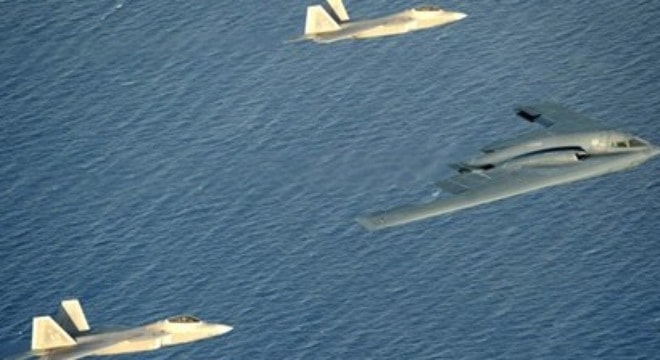Deploying B-2 bombers, the US sends a message to China
The US recently deployed three B-2 Spirit stealth strategic bombers in Guam as part of its Asia-Pacific "pivot" strategy and to send a message to China.
 |
| The B-2 Spirit was escorted by two F-22 stealth fighters in Guam. Photo: US Nav |
The US news site Washington Free Beacon on August 28 quoted US Navy Admiral Cecil Haney of the US Strategic Command as saying that the deployment of the B-2 squadron for training demonstrates the US's continued commitment to global strategic air operations in the Asia-Pacific region, while implementing President Barack Obama's flexible and reliable military options to meet the national security requirements of the US and its allies.
Admiral Haney said the deployment of B-2 strategic nuclear bombers was intended to send a message to America's allies and adversaries.
“It is important for US Strategic Command to continue to exercise global strike capabilities and enhance deterrence against potential adversaries, while ensuring the security of our allies through these types of deployments,” Haney said.
The Global Times quoted an unnamed Chinese military expert as saying that a US P-8 anti-submarine aircraft was intercepted last week because it had “seriously interfered” with a Chinese submarine operating in the South China Sea.
Admiral Haney said the US military “is on 24-hour, seven-day-a-week surveillance as we conduct operations to detect and prevent strategic attacks on the United States and our allies.”
Deploying such strategic bombers is just one way the US Pacific Command maintains stability,” he said.
For much of August, advanced US stealth bombers were based on the western Pacific island, conducting missions described by the US Air Force as “combat readiness enhancement” operations.
US Air Force spokesman Ray Geoffroy said the B-2s flew training near Guam and in the Pacific Command area of responsibility. Training included command and control, aerial refueling and weapons placement. Captain Geoffroy said the stealth bomber deployment was planned recently.
The B-2 Spirit aircraft, which can carry nuclear or conventional weapons, was deployed by the US to the Asia-Pacific region to support allies Japan and South Korea in dealing with nuclear weapons from China and the Democratic People's Republic of Korea. This is the first time the B-2 has been deployed in the Asia-Pacific region since January 2012.
Monitoring Chinese submarines?
The US deployed the B-2 at the same time that a US P-8 anti-submarine aircraft was intercepted by Chinese fighter jets over the South China Sea. The Pentagon called the action “dangerous and provocative”, but China rejected the accusation and demanded that the US stop reconnaissance flights over its coastal waters.
Immediately, the US dispatched the second aircraft carrier strike group, USS Carl Vinson, to the western Pacific. The Sankei Shimbun (Japan) recently reported that, following the deployment of the B-2, the US Air Force also plans to send more than 20 B-52 “flying fortresses” to Anderson Air Force Base in Guam.
British news agency Reuters on August 28 quoted the Chinese newspaper Global Times as saying that Major General Zhang Zhaozhong of China's National Defense University urged fighter pilots to intercept US reconnaissance aircraft flying even closer.
The general's comments reflect the views of Chinese military experts, demonstrating Beijing's determination to protect its expanding fleet of nuclear-powered ballistic missile submarines from US spy planes.
Chinese experts believe that the target of US surveillance could be the Chinese submarine fleet based on Hainan Island. Among these are Jin-class nuclear submarines capable of carrying Julang ballistic missiles - the main weapon in China's nuclear deterrence strategy.
According to Tien Phong






